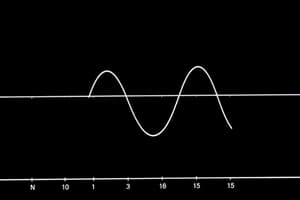Podcast
Questions and Answers
What is chemical kinetics?
What is chemical kinetics?
The measurement of how quickly reactions occur.
Which of the following can be measured to determine the rate of reaction? (Select all that apply)
Which of the following can be measured to determine the rate of reaction? (Select all that apply)
- Volume of gas given off (correct)
- Change in concentration (correct)
- Change in temperature
- Change in mass (correct)
Rate of reaction is directly proportional to the concentration of chemical species.
Rate of reaction is directly proportional to the concentration of chemical species.
True (A)
What happens to the rate if the concentration of substance D is doubled?
What happens to the rate if the concentration of substance D is doubled?
How can rate be calculated from a linear graph?
How can rate be calculated from a linear graph?
What does the rate constant (k) indicate?
What does the rate constant (k) indicate?
Which of the following factors affect the rate constant (k)?
Which of the following factors affect the rate constant (k)?
What are the orders of reaction?
What are the orders of reaction?
The overall order is the sum of all individual orders, represented as ____ = m + n.
The overall order is the sum of all individual orders, represented as ____ = m + n.
Exponents in the rate equation are related to the stoichiometric coefficients from the chemical equation.
Exponents in the rate equation are related to the stoichiometric coefficients from the chemical equation.
Flashcards are hidden until you start studying
Study Notes
Introduction to Chemical Kinetics
- Chemical kinetics measures the speed of reactions and how changing conditions impact it.
- Understanding reaction kinetics can improve various processes.
- Knowing when to hold a reaction at a certain stage is essential to ensure completion before proceeding.
- Certain reagents can enhance specific reaction steps.
Kinetic Rates
- Rate of reaction is defined as the change in concentration of a chemical species over time.
- Measurement techniques for reaction rate include:
- Volume of gas produced
- Change in mass
- Change in concentration
- Change in color
- Change in electrical conductivity
- Change in pH
- Other measurable physical property changes
Concentration and Rate of Reaction
- The rate of reaction is directly proportional to the concentration of reactants.
- If the concentration of a reactant (e.g., D) doubles, the reaction rate also doubles.
- The relationship can be expressed as:
- Rate ∝ [D] or Rate = k[D]
Calculating Rate from Graphs
- The gradient of a linear graph directly provides the rate of reaction.
- For nonlinear graphs, calculate the gradient of a tangent drawn at a point.
- Greater triangle sections yield more accurate gradient calculations.
Rate Equation and Orders
- The rate equation connects the rate of reaction to the concentrations of reactants.
- The rate constant (k) is unique to each reaction and varies exclusively with temperature.
- As temperature increases, k increases due to more frequent particle collisions, while concentrations remain constant.
Order of Reaction
- The order of reaction, derived from experimental data, indicates how concentration impacts reaction rate.
- Types of orders include:
- Zero order: Concentration changes do not affect rate.
- First order: Rate changes proportionally with concentration change.
- Second order: Rate changes with the square of the concentration change.
- Overall order is the sum of individual orders, expressed as Overall order = m + n.
Rate Law
- Exponents in the rate law are determined experimentally and are not tied to stoichiometric coefficients.
- Rate equations can include reactants, products, and catalysts, but not intermediates formed during the reaction.
Experimental Determination of Rate Equation
- Initial rate experimental data can be employed to determine the rate equation.
- Rates can be calculated using established rate equations, incorporating the concentration of reactants and the rate constant.
Summary of Concepts
- Rate constant (k) reflects the speed of a reaction; higher values imply faster reactions but remain constant at a given temperature.
- Understanding the various factors affecting reaction rates is essential for practical applications in chemical processes.
Studying That Suits You
Use AI to generate personalized quizzes and flashcards to suit your learning preferences.


